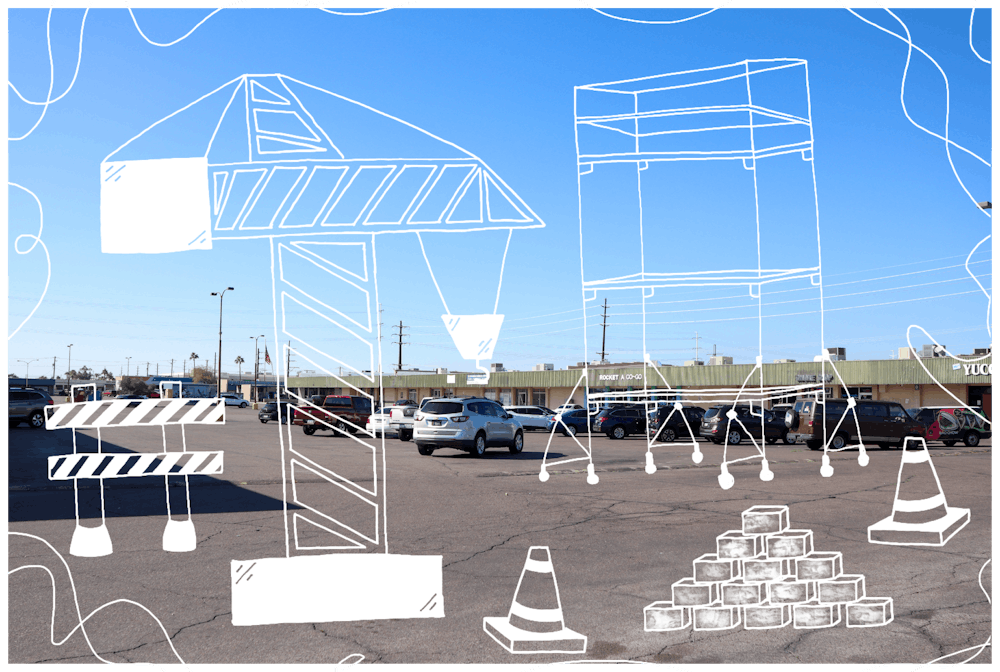Tempe City Council unanimously voted in favor of going through with plans to redevelop Danelle Plaza, a 14-acre shopping center in the heart of Tempe. The renovation plan includes decisions to add more small businesses and to increase Danelle Plaza’s artistic qualities, such as public art, live music and culture.
Rob Moore, the coordinator of The Danelle Project who joined in planning the development in 2016, said he hopes the plaza will offer a way for Tempe to support the local art scene. The Danelle Plaza, located on the southwest corner of Southern Avenue and Mill Avenue, is valuable because it preserves culture, according to Moore.
Culture means many things to Moore, but most importantly for the plaza, it means something that is a foundation for many different types of people and diverse lifestyles.
Moore said Danelle Plaza has "gone through multiple iterations" since the 1960s when Tempe was initially an "agrarian," or agriculture-based, economy.
Over the years, Danelle Plaza has seen an underground skate park, various music venues and has remained a meeting place for creatives. The location has served as a culturally influential site for figures in the 1970s punk and new wave scenes that would later attract Los Angeles bands.
"It's counterintuitive to say: 'Well, this is a strip mall, strip malls don't influence culture,' but the reality is art comes from places like this," he said. "It comes from our neighborhoods and there's diversity in that too."
Moore said the plan for Danelle Plaza is to keep the influence from the past in mind and implement it into the redevelopment.
"The plaza has a really interesting heritage with Native American culture," Moore said. "There's a canal that runs diagonally through it, and so there is that history beneath the asphalt."
Throughout the late 2010s, Moore contracted multiple Indigenous artists to paint murals and add their own artistic flair to the plaza. One of those artists is Tyson Powless, an Arizona local who is involved in many artistic scenes across Phoenix and Tempe, including his own fashion brand and musical bands.
He said he was thankful for the opportunity, because growing up, he did not often see "companies and young people using Native or Indigenous wear."
Powless said he hopes Tempe will allow for more Indigenous artists to display their work in many areas, including Danelle Plaza, because in his opinion, it is rare for Native American artists to be supported by their city.
"Where do I fit in as a Native American Indigenous person?" he asked.
Powless also said his hopes for Danelle Plaza are that it is able to maintain itself without being demolished or "turned into a resort or a parking lot."
Anitra Molina, another Indigenous artist on the project agrees.
A mural she made for Danelle Plaza with a fellow artist, Dwayne Manuel, was titled "Defend the Soul" and featured characters she painted called "Nopalitos."
"We just wanted to pay homage to the original peoples that called this place home," Molina said. "Defending the sacred just means defending the water (and) defending the land from overdevelopment."
Molina said she has a history with Danelle Plaza — she has been going to the Yucca Tap Room since she was a kid.
"(Danelle Plaza’s) live music is a heartbeat and is a reference to the counterculture of underground music," she said. "I hope it gets to maintain its character because there's a lot of redevelopment going around all over the Valley and the cities are losing their character."
Nolan Williams, co-founder and president of Tempe Yes In My Back Yard campaign, said in an emailed statement that Danelle Plaza should keep its cultural and artistic amenities, but affordable housing should also be added.
"Tempe needs new homes," he said, also mentioning the low vacancy rate in the city relative to the rest of the state.
In 2019, ASU Professor Elena Rocchi decided that it would be beneficial for Danelle Plaza to use some input from ASU students. She gathered a class of about 120 students to get feedback about the future use of the plaza.
"The students first had to do work with the community," Rocchi said. "They interviewed artists for a month and artists would come to school every week, and we had a lecture with the former mayor."
Rocchi said her own interest in Danelle Plaza comes from wanting to see the culture of Danelle Plaza live on.
"I struggle when I see demolitions," Rocchi said. "I think that in every little piece that exists, there is a possibility for us to tell that story because once the place belongs to the memory of people, it belongs to the community."
Edited by Grey Gartin, Alysa Horton and Caera Learmonth.
Reach the reporter at njarret1@asu.edu and @nataliajarrett on X.
Like The State Press on Facebook and follow @statepress on X.
Natalia is a sophomore studying journalism and mass communication. This is her fourth semester with The State Press. She has also worked as a politics reporter.




